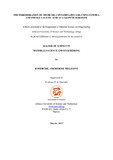| dc.contributor.author | Igwebuike, Chidiebere, Millicent | |
| dc.date.accessioned | 2018-01-24T11:01:12Z | |
| dc.date.available | 2018-01-24T11:01:12Z | |
| dc.date.issued | 2017-03-22 | |
| dc.identifier.uri | http://repository.aust.edu.ng/xmlui/handle/123456789/643 | |
| dc.description.abstract | One of the unintended impacts of crude oil exploration is the pollution of agricultural land and aquatic resources when there is accidental oil spillage. The environmental effect of this has resulted in untold hardship to communities within oil producing regions all over the world and has been the main reason for conflicts in the regions. Nigerian Niger Delta region has been devastated by oil pollution and gas flaring, and both the government of Nigeria and the multinational oil producing companies have been searching for solutions for the recovery of oil polluted soil. Among the various possible methods of recovery of crude oil contaminated soil, bioremediation is most environmentally friendly.
A promising bioremediation method is the use of crops with phytoremediation capabilities. Cowpea (Vigna unguiculata) which belongs to the family of legumes is one of such crops. In addition to their nutritional value, legumes can be used in the cleaning up of crude oil contaminated soils through different mechanisms such as; biodegradation in the rhizosphere, plant uptake, translocation, transformation, and phytovolatilization.
This research was aimed at evaluating the phytoremediation capabilities of cowpea towards the recovery of crude oil contaminated soil in the Niger Delta region of Nigeria. Five (5) plastic buckets with 1000g of soils were contaminated with crude oil at different levels; 0 ml, 30 ml and 40 ml. The remaining two buckets contained 30 ml crude oil + 0.5g Indole acetic acid (IAA) and 40 ml crude oil + 0.5g IAA respectively. The Indole Acetic (IAA) - a growth hormone was introduced to the contaminated soil to improve performance. Cowpea was grown in the soil and the germination and height of the crop were monitored. The presence of heavy metals in the soil and plant were measured.
Results show that the heights of cowpea plants in the control experiment were greater than those of plants in 30 ml crude oil + IAA, while the plants in 30 ml crude oil only being the least. Atomic absorption spectroscopy analysis of the plant samples indicated cowpea plants in 40 ml crude oil + IAA to have the highest accumulation of heavy metals. EDXRF results of the soil samples presented the soil with 40 ml of crude oil to have the highest accumulation
of heavy metals.
These results indicate that cowpea has phytoremediation capabilities. Indole-3-acetic acid has the potential of facilitating the rate of phytoremediation of contaminated soil. Thus, it is concluded that cowpea can be used to clean-up crude oil contaminated farm lands in the Niger Delta, Nigeria. | en_US |
| dc.description.sponsorship | AUST,ADB & ACBF. | en_US |
| dc.language.iso | en | en_US |
| dc.subject | Igwebuike, Chidiebere Millicent | en_US |
| dc.subject | Prof Peter A. Onwualu | en_US |
| dc.subject | 2016 Materials Science and Engineering | en_US |
| dc.subject | Cowpea and Indole-3-Acetic Acid | en_US |
| dc.subject | Phytoremediation | en_US |
| dc.subject | Phytoremediation of Crude Oil Contaminated Soil | en_US |
| dc.subject | Phytoremediation of Crude Oil Contaminated Soil Using Cowpea and Indole-3-Acetic Acid as a Growth Hormone | en_US |
| dc.title | Phytoremediation of Crude Oil Contaminated Soil Using Cowpea and Indole-3-Acetic Acid as a Growth Hormone | en_US |
| dc.type | Thesis | en_US |

